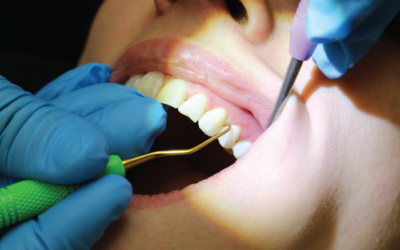When to Grab It: The Columbia 13-14 Curette
In dental hygiene, we spend so much time mastering our training of many different dental instruments. If you find yourself ever wondering—wait, what does this one do again? —this is an excellent refresher for you. If you want to elevate your hygiene armamentarium, you need a universal curette and wow, do I have the recommendation for you. The Columbia 13-14 is a must-have instrument in all hygiene kits for its many purposes and is gloved hands down, my favorite instrument.
Columbia 13-14 Classification
This hygiene instrument classifies as a universal curette that adapts for instrumentation on any tooth surface. The working ends are paired images that offer two parallel cutting edges on a curved blade. The face of the instrument is flat in cross-section and curved lengthwise, converging with the two lateral-bladed surfaces to form the tip of the scaler. The working end is rounded on a universal and called the toe of the instrument. This rounded edge is unlike a sickle scaler which has a pointed tip, making the toe of the Columbia 13-14 ideal for working on all crown and root surfaces.
The American Eagle Columbia 13-14 Curette has a blade that is slightly broad and curved for optimal accessibility to interproximal and root concavities of the dentition. The shank of the Columbia 13-14 has familiar bends and tooth adaptation as its fellow universal curette, the Barnhart 5-6, however, the terminal shank is 2 millimeters shorter, and the working end is slightly broader. This design makes a superior instrument for moderate to heavy calculus removal at any site.
Where to Use the Columbia 13-14
The design of the Columbia 13-14 is for full dentition use in both supra and subgingival sites of the teeth and root surfaces, and equally efficient in anterior and posterior regions. Although the blade is bilateral, you’ll find a rounded back end of this instrument, allowing subgingival scaling without causing gingival tissue trauma.
Using oblique exploratory strokes, walk the Columbia 13-14 from the distal line angle to the far posterior, and again from the distal lingual angle across the buccal and lingual sides to the mesial interproximal space of the tooth. To accommodate the width of the toe in tight interproximal spots with deep pocket depths, insert the instrument at 0° to reach the junctional epithelium before implementing the standard 70-80° angle of your working stroke.
WATCH NOW: FREE ON-DEMAND CE WEBINAR
Instrumentation Reimagined: The Future of Hand Scaling Has Arrived
When to Use the Columbia 13-14
Pass the Columbia. You’ll hear this at my office every day from both the hygienists and periodontist because we love using the Columbia 13-14 for all of our procedures. Read on for the special attributes of this instrument.
Full Dentition Calculus Removal
It’s fitting that the Columbia curette shares a name with the nation’s capital as it’s a true leader of the instrument kit. The strength of the 8-millimeter terminal shank and toe broadness allows the clinician to remove calculus, no matter the tenacity, from any site on any tooth. Because of the 1-millimeter width of the Columbia 13-14 working end, traditional stainless-steel designs may be too bulky for some sites, making XP® Sharpen-Free Instruments an excellent option. With XP technology, the working end is as narrow as possible, allowing for comfortable subgingival access. I prefer to have each available in every kit, especially for active therapy procedures.
The Scaling and Root Planing Savior
The rounded toe of the Columbia 13-14 makes it safe to plane the softer root surfaces. Root depressions and concavities are breeding grounds for plaque and bacteria that require efficient scaling to enable gingival reattachment. Using oblique exploratory strokes, position the toe apical to discovered subgingival deposit and remove it with lateral pressure. Continue to plane the root surface until smooth without worrying about scoring the cementum like a sickle scaler could. When combined with ultrasonics, this instrument can be used solely for scaling and root planing; it’s that good.
Removal of Lingual Anterior Stains
Efficient full dentition deposit removal and quick stain removal? Does it make coffee too? No, but it can take care of that coffee stain! Lingual anterior stains are removed quickly with simple vertical strokes of the Columbia 13-14, making this curette an all-in-one instrument to start and finish with.
Benefits of Clinical Use
Maximize Your Working Stroke
You’ll love how well the Columbia 13-14 removes deposit, and the sharper you maintain your instrument, the more efficient you’ll be. The patented technology used on XP Sharpen-Free Instruments eliminates the need to sharpen these instruments throughout their usable lifespan, which is just as long as traditional stainless-steel instruments, if not longer. You’ll modify your working stroke with these instruments, shaving the calculus away from the outermost layer until the tooth is definitively debrided.
A Real Time Saver
Scaling high and low at 360° to remove calculus, plaque, and stain—the Columbia 13-14 is so versatile that it saves you a lot of time in your clinical appointments. In addition, you can avoid frequently changing out site-specific scalers with this universal wonder.
Improved Ergonomics
The risk of hand and wrist deterioration is minimized when working with well-maintained instruments. Implementing the Columbia 13-14 in all your procedures removes deposit efficiently without musculoskeletal strain or injury. Strokes and grasp are much lighter with XP Sharpen-Free instruments, creating less operator fatigue and a noticeably more comfortable visit for your patients.
A Universal Wonder
If I am ever the recipient of a dental hygienist trophy, I dream that the trophy would be a mounted Columbia 13-14. In my speech I’d thank the Columbia for saving my wrist even through the toughest debridement, removing all unsightly coffee stains without struggle, and saving me enough time at the end of each appointment to build up my own coffee stain. Thank you, Columbia 13-14!





